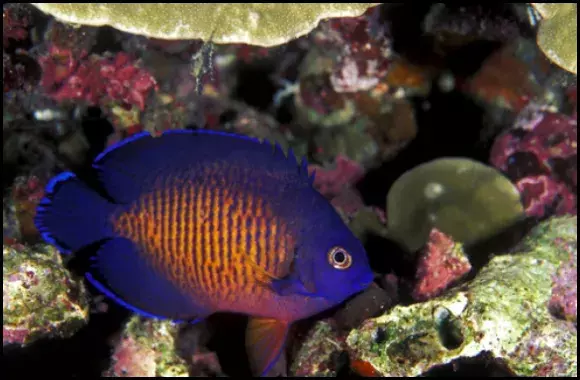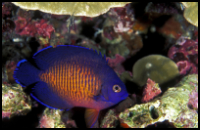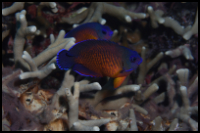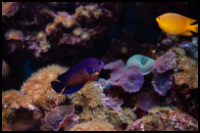




Quick Care Details (Table)
| Livestock Characteristics | Value |
|---|---|
| Care Level | Moderate |
| Temperament | Semi-Aggressive |
| Diet | Omnivore |
| Maximum Size | 4 Inches |
| Minimum Tank Size | 30 Gallons |
| Reef Compatible | With Caution |
| Temperature Range | 72-78F |
| PH Range | 8.1-8.4 |
| DKH Range | 8-12 |
| Salinity Range | 1.020-1.025 |
Species Specific Categories
Helpful Video
Care Details
Aquascape
- Create a reef-style aquascape with live rock structures, providing hiding spots and swimming spaces for the Coral Beauty Angelfish.
- Incorporate corals and other invertebrates, as these fish thrive in environments with abundant coral growth.
- Use natural-looking materials and ensure the layout allows for easy maintenance and cleaning.
Substrate
- Use a fine to medium-sized sand substrate to mimic the sandy seabeds of their natural habitat.
- A sand bed provides opportunities for the angelfish to forage and sift through the sand.
Disease Prevention
- Quarantine new fish before introducing them to the main aquarium to prevent the spread of diseases.
- Maintain excellent water quality through regular testing and water changes to reduce stress and improve fish health.
- Avoid introducing fish with visible signs of disease or parasites.
Filtration
- Use a quality filtration system to remove waste and maintain water clarity.
- Consider a combination of mechanical, biological, and chemical filtration methods to keep the water clean and clear.
Lighting
- Provide moderate to high-intensity lighting to support the growth of corals and enhance the vibrant colors of the Coral Beauty Angelfish.
- Ensure the lighting system is suitable for the corals and other photosynthetic organisms in the aquarium.
Water Flow
- Coral Beauty Angelfish prefer moderate water flow, simulating the gentle currents found in their natural reef environment.
- Use powerheads or circulation pumps to create adequate water movement without causing excessive stress.
Hardiness
- The Coral Beauty Angelfish is considered relatively hardy and adaptable when provided with proper care and a suitable environment.
- They can tolerate a range of water conditions but still require stable parameters.
Acclimation
- Properly acclimate new fish to the aquarium water temperature and chemistry to minimize stress.
- Gradually introduce them to the tank environment to allow them to adjust slowly.
Special Requirements
- Coral Beauty Angelfish may nip at corals and some invertebrates, so be cautious when selecting tankmates and corals.
- Provide a varied diet with a mix of quality flakes, pellets, frozen foods, and even some live foods to ensure proper nutrition.
- Be mindful of their territorial behavior and ensure there are enough hiding places to reduce aggression.
Temperament and Behavior
Behavior and Social Interaction
- Coral Beauty Angelfish are generally peaceful but may exhibit territorial behavior, especially towards other angelfish or similarly shaped species.
- They are known for their inquisitive and active nature, often exploring their surroundings and interacting with the environment.
Aggression
- While Coral Beauty Angelfish are not considered highly aggressive, they may become territorial, especially in smaller tanks or when competing for resources.
- Aggression is usually more pronounced when housed with other angelfish or similar species.
Breeding
- Breeding Coral Beauty Angelfish in captivity can be challenging but is possible with the right conditions.
- They are egg-layers and will deposit adhesive eggs on suitable surfaces, often on the sides of rocks or crevices.
- Raising the offspring requires a separate rearing tank and specialized care.
Compatibility
- Coral Beauty Angelfish can be compatible with a variety of peaceful fish species, especially in reef aquariums.
- Avoid housing them with large, aggressive, or predatory fish that might harm or intimidate them.
- Exercise caution when introducing them to other angelfish or fish with similar body shapes, as territorial disputes may arise.
Activity Level
- Coral Beauty Angelfish are generally active swimmers, continuously exploring their surroundings.
- They often interact with live rock structures and corals, picking at algae and small invertebrates on the surfaces.
Clean-up Crew
- Coral Beauty Angelfish may help with algae control to some extent, but they are not as effective as dedicated "clean-up crew" species like certain snails and hermit crabs.
- Consider adding algae-eating snails, hermit crabs, and other small scavengers to help maintain a balanced ecosystem.
Schooling or Shoaling Behavior
- Coral Beauty Angelfish do not exhibit schooling or shoaling behavior. They are typically found as solitary individuals in the wild.
- However, they can be kept in pairs or small groups in larger aquariums, provided there is enough space and appropriate territories are established.
Diet and Nutrition
Dry Foods
- Accepts high-quality marine flake and pellet foods.
- Look for products that contain a variety of ingredients to ensure a balanced diet.
- Dry foods are convenient and easy to store, making them a staple in many aquariums.
Frozen Foods
- Enjoys a variety of frozen foods, such as brine shrimp, mysis shrimp, and cyclops.
- Frozen foods provide essential nutrients and help simulate a natural diet.
- Feed a mix of different frozen foods to ensure a diverse diet.
Live Foods
- Will readily consume live foods like brine shrimp nauplii and copepods.
- Live foods are highly nutritious and mimic prey items found in the wild.
- Consider cultivating live foods to provide a sustainable and readily available food source.
Vegetables
- May occasionally nibble on small pieces of blanched vegetables like spinach or zucchini.
- Vegetables provide dietary fiber and can be a healthy addition to their diet.
- Offer vegetables sparingly, as they are primarily omnivores and require a mix of animal and plant-based foods.
Algae
- Appreciates marine algae or seaweed sheets.
- Algae is a natural part of their diet in the wild and provides essential nutrients.
- Attach seaweed sheets to a clip or rock to allow the fish to graze comfortably.
Feeding Schedule
- Feed small amounts multiple times a day rather than a large single feeding.
- Aim for at least 2 to 3 feedings daily to ensure the fish receive enough food.
- Regular and consistent feeding helps maintain the fish's health and vibrant colors.
Supplemental Foods
- Consider offering vitamin and mineral supplements occasionally.
- Supplements can enhance the fish's diet and support overall health.
- Use supplements sparingly and in accordance with the manufacturer's instructions.
Tank Parameters
Tank Size
- The minimum recommended tank size for a single Coral Beauty Angelfish is around 30 gallons (113 liters).
- Larger tanks, such as 55 gallons (208 liters) or more, will provide more swimming space and reduce territorial behavior.
Tank Length and Measurements
- For a single Coral Beauty Angelfish, a tank with dimensions of at least 24 inches (60 centimeters) in length is appropriate.
- Larger tanks with more length and width are preferable for keeping multiple angelfish or creating a community aquarium.
Species Maximum Size
- Coral Beauty Angelfish can reach a maximum size of about 4 inches (10 centimeters) in length.
- When considering tank mates, take into account the maximum size of both the angelfish and the other fish to ensure compatibility.
Water Temperature
- The ideal water temperature for Coral Beauty Angelfish is generally between 72°F to 78°F (22°C to 26°C).
- It's crucial to maintain a stable temperature within this range to prevent stress and potential health issues.
pH (Acidity/Alkalinity)
- The recommended pH range for Coral Beauty Angelfish is between 8.1 to 8.4.
- Keeping the pH within this range helps to ensure proper fish health and biochemical processes.
Nitrate (NO3) Levels
- Keep nitrate levels in the aquarium below 20 ppm (parts per million) for the well-being of Coral Beauty Angelfish.
- Regular water changes and proper filtration are essential to control nitrate levels.
Salinity
- Coral Beauty Angelfish are marine fish and require a salinity level between 1.020 to 1.025 specific gravity (sg).
- Use a reliable hydrometer or refractometer to measure and maintain the salinity within the recommended range.
Phosphate (PO4)
- Aim to keep phosphate levels in the aquarium below 0.03 ppm (parts per million).
- High phosphate levels can contribute to algae growth and negatively impact water quality.
Alkalinity (dKH)
- The recommended alkalinity level for a reef aquarium with Coral Beauty Angelfish is between 8 to 11 dKH.
- Alkalinity is crucial for maintaining stable pH levels and supporting coral growth.
Iodine (I)
- While iodine is essential for some marine organisms, it is generally not necessary to supplement it in a well-maintained reef aquarium with Coral Beauty Angelfish.
- Proper water changes and a balanced diet should provide sufficient iodine for their needs.
History, Popularity, History and Species Variety Details
The History, Popularity and Habitat
History
The history of the Coral Beauty Angelfish, scientifically known as Centropyge bispinosa, traces back to its discovery and documentation. The species was first described in 1862 by the renowned French zoologist Achille Valenciennes. As a member of the Pomacanthidae family, this colorful marine fish belongs to a diverse group of angelfish that inhabit tropical and subtropical coral reefs around the world.
Over the years, the Coral Beauty Angelfish has gained popularity among marine aquarium enthusiasts due to its striking colors, relatively small size, and manageable temperament compared to some other angelfish species. In the late 20th century and early 21st century, advancements in marine aquarium technology and the increased accessibility of the global aquarium trade contributed to the popularity of the species as a highly sought-after addition to reef tanks.
Popularity
The Coral Beauty Angelfish has become one of the most popular species of marine angelfish in the aquarium trade. Its striking appearance, featuring a deep royal blue or purple-blue body adorned with bright orange to red-orange vertical stripes, captivates hobbyists and enthusiasts alike. The vibrant coloration of the dorsal fin, often highlighted with iridescent blue or green, adds to its allure.
Aquarium keepers are drawn to the Coral Beauty Angelfish not only for its aesthetic appeal but also for its relatively peaceful temperament compared to other angelfish species. This makes it a suitable choice for reef aquariums with corals and other invertebrates, as well as community setups with other peaceful fish species.
The Coral Beauty Angelfish's smaller size, reaching a maximum length of about 4 inches (10 centimeters), makes it suitable for smaller to medium-sized aquariums, increasing its popularity among hobbyists with limited space. Its adaptability to a wide range of water conditions also contributes to its widespread appeal.
Habitat
In the wild, the Coral Beauty Angelfish inhabits the coral reefs of the Indo-Pacific region, specifically in the Indian Ocean and the western Pacific Ocean. These tropical and subtropical reef environments offer the fish an abundant supply of corals and other invertebrates to graze on.
Coral Beauty Angelfish are commonly found in lagoons, reef slopes, and outer reef areas, where they swim among the intricate coral formations. The rocky crevices and coral branches provide them with shelter and hiding places, while also serving as ideal locations for their egg-laying during breeding.
Their natural habitat's availability of algae, small invertebrates, and zooplankton offers a diverse diet, which is essential for their health and vibrant coloration. To replicate their natural environment in captivity, aquarium keepers aim to create reef-style aquascapes with live rock structures, providing plenty of hiding spots and swimming spaces for the Coral Beauty Angelfish.
Overall, the history, popularity, and habitat of the Coral Beauty Angelfish make it a cherished and sought-after species in the marine aquarium hobby. Responsible and knowledgeable care of these stunning fish allows enthusiasts to experience the beauty and wonder of the coral reefs right in their own living spaces.
Variations in the Coral Beauty
- Color Intensity: The intensity of colors, particularly the blue and orange/red hues, can vary among individual Coral Beauty Angelfish. Some may display more vivid and vibrant colors, while others may have slightly muted tones.
- Blue and Purple Dominance: While most Coral Beauty Angelfish have a combination of blue and orange/red coloration, some individuals may exhibit a more pronounced blue or purple body coloration.
- Striking Orange: In some specimens, the vertical orange/red stripes can be exceptionally striking and may cover more of the body, making the fish appear predominantly orange.
- Golden or Yellow: Rarely, there may be individuals with more yellow or golden tones instead of the typical orange/red coloration.
- White or Cream Patches: Some Coral Beauty Angelfish may display patches of white or cream on their body, adding a unique touch to their appearance.
- Longer or Shorter Fins: While not a separate variation, individual differences in fin length can occur among Coral Beauty Angelfish.
Common Tank mates
- Clownfish: Clownfish are peaceful and social fish that can coexist harmoniously with Coral Beauty Angelfish. They come in various species and colors, offering a visually appealing combination.
- Gobies: Many goby species are suitable tank mates for the Coral Beauty Angelfish. Gobies are known for their interesting behaviors and will not typically bother the angelfish.
- Hawkfish: These fascinating fish add a unique element to the aquarium with their perching behavior. They usually leave other fish, including the Coral Beauty Angelfish, undisturbed.
- Wrasses: Many species of wrasses are peaceful and can be good companions for the Coral Beauty Angelfish. Look for smaller, non-aggressive wrasse species.
- Chromis: Chromis are schooling fish that create a beautiful visual effect in the tank. They are generally peaceful and can be kept with the Coral Beauty Angelfish.
- Cardinalfish: Cardinalfish are docile and peaceful, making them compatible tank mates for the Coral Beauty Angelfish.
- Royal Gramma Basslet: These small, colorful fish are known for their peaceful temperament and can coexist with the Coral Beauty Angelfish.
- Firefish Gobies: Firefish gobies are peaceful and add a dash of color to the aquarium. They generally avoid confrontations with other fish.
- Dottybacks: Some dottyback species, particularly those with less aggressive tendencies, can be suitable companions for the Coral Beauty Angelfish.
- Small Tangs and Surgeonfish: Some smaller tang species, like the Yellow Tang (Zebrasoma flavescens), can work well with the Coral Beauty Angelfish in larger tanks with ample swimming space.
Breeding
Yes, it is possible to breed the Coral Beauty Angelfish (Centropyge bispinosa) in a well-maintained aquarium environment under the right conditions. However, it's essential to understand that breeding marine angelfish, including the Coral Beauty, can be challenging and requires a dedicated effort, patience, and proper preparation.Keep in mind that breeding angelfish in captivity, including the Coral Beauty Angelfish, is not a guarantee. Even with the best efforts, successful breeding may not occur, as it depends on several factors, including the compatibility of the pair, their health, and the specific tank conditions. If breeding is not the primary goal, simply enjoying these beautiful fish in a well-maintained reef aquarium can be a rewarding experience.
Disease and Quarantine
Copper Treatment
- Purpose: Copper treatment is primarily used to combat external parasites, such as marine ich (Cryptocaryon irritans) and marine velvet (Amyloodinium ocellatum).
- Tolerance: Coral Beauty Angelfish can be sensitive to copper. Use caution and carefully monitor the fish during treatment to prevent copper toxicity.
Hyposalinity
- Purpose: Hyposalinity involves lowering the salinity of the water to treat certain external parasites like marine ich, as they cannot tolerate the lower salinity levels.
- Tolerance: Coral Beauty Angelfish can tolerate gradual changes in salinity. However, corals and other invertebrates in the tank may not tolerate low salinity levels and should be removed during treatment.
Freshwater Dip
- Purpose: A short dip in freshwater helps dislodge and kill external parasites on the fish's body.
- Tolerance: Coral Beauty Angelfish can tolerate a brief freshwater dip, but it can cause stress. Use with caution and monitor the fish closely.
Methylene Blue
- Purpose: Methylene blue is used to treat fungal and bacterial infections and can also help with egg fungus in breeding situations.
- Tolerance: Coral Beauty Angelfish can tolerate methylene blue when used at proper dosages. However, it may affect water quality, so use it carefully.
Praziquantel
- Purpose: Praziquantel is an effective treatment for internal parasites, particularly worms and flukes.
- Tolerance: Coral Beauty Angelfish can tolerate praziquantel when used at appropriate dosages.
Metronidazole
- Purpose: Metronidazole treats internal parasites, particularly flagellates and some protozoan infections.
- Tolerance: Coral Beauty Angelfish can tolerate metronidazole when used as directed.
Formalin
- Purpose: Formalin is used to treat external parasites and fungal infections.
- Tolerance: Coral Beauty Angelfish can be sensitive to formalin. Use with caution and closely monitor the fish during treatment.
Antibiotics
- Purpose: Antibiotics are used to treat bacterial infections in fish.
- Tolerance: Coral Beauty Angelfish can be sensitive to antibiotics. Use antibiotics only under the guidance of a veterinarian.
Acriflavine
- Purpose: Acriflavine is used to treat external parasites and fungal infections.
- Tolerance: Coral Beauty Angelfish can be sensitive to acriflavine. Use with caution and closely observe the fish during treatment.
Frequently Asked Questions
What should I feed my Coral Beauty Angelfish?
Offer a varied diet of high-quality angelfish pellets, flakes, frozen foods like brine shrimp and mysis shrimp, and occasional live foods to ensure a balanced diet.
Can Coral Beauty Angelfish be kept in a reef aquarium?
Yes, they can be reef-safe, but caution should be exercised when introducing them to corals and other invertebrates as they may nip at certain soft and stony corals.
Are Coral Beauty Angelfish aggressive?
While they can be territorial, Coral Beauty Angelfish are generally considered peaceful, especially compared to some other angelfish species.
How many Coral Beauty Angelfish can I keep in my aquarium?
It's best to keep a single Coral Beauty Angelfish in smaller tanks. Larger tanks may allow for keeping multiple individuals, but they should be introduced simultaneously.
Can Coral Beauty Angelfish change gender?
No, Coral Beauty Angelfish do not change gender. They are born either male or female.
Are Coral Beauty Angelfish suitable for beginner hobbyists?
They can be suitable for beginner hobbyists with some previous experience in keeping marine fish. Their care requirements and compatibility with tank mates should be understood.
Do Coral Beauty Angelfish need a lot of hiding spots in the aquarium?
Yes, providing ample live rock and hiding spots is essential for their well-being and to reduce stress.

